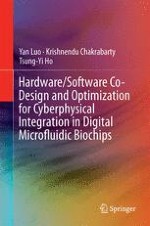2015 | OriginalPaper | Chapter
7. Pin-Limited Cyberphysical Microfluidic Biochip
Authors : Yan Luo, Krishnendu Chakrabarty, Tsung-Yi Ho
Published in: Hardware/Software Co-Design and Optimization for Cyberphysical Integration in Digital Microfluidic Biochips
Publisher: Springer International Publishing
Activate our intelligent search to find suitable subject content or patents.
Select sections of text to find matching patents with Artificial Intelligence. powered by
Select sections of text to find additional relevant content using AI-assisted search. powered by
